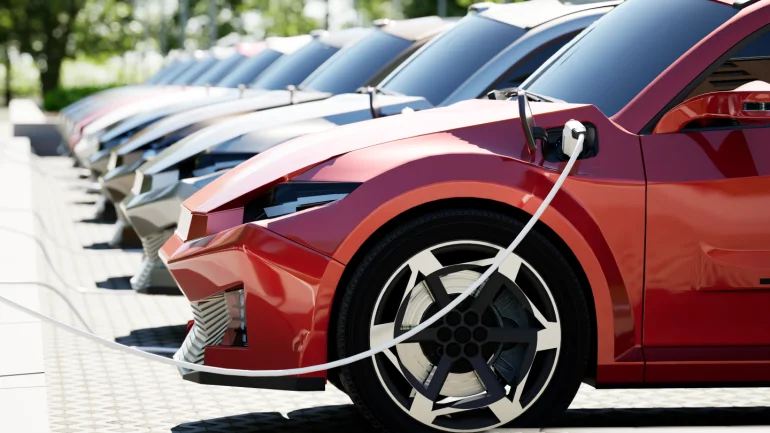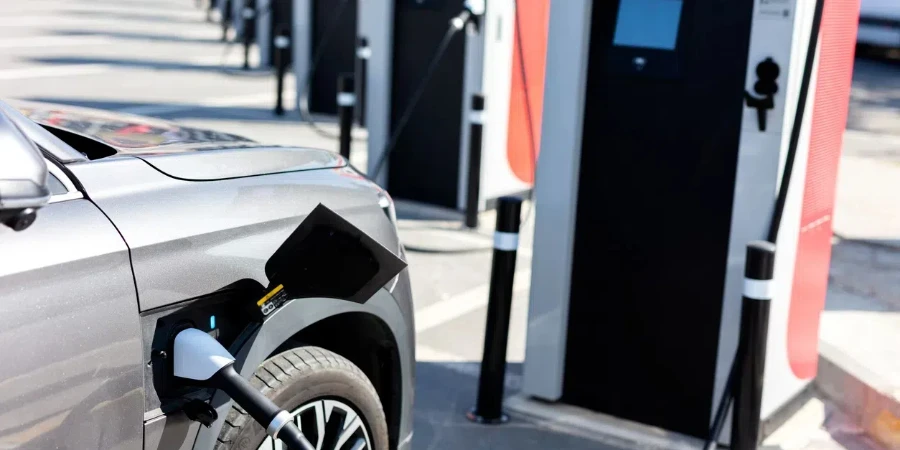Amid a slowdown in global EV demand, automakers are shifting focus back to HEVs and ICE vehicles.

In 2024, the automotive industry has been witness to an ongoing downturn in the battery electric vehicle (BEV) markets, leaving companies grappling with reduced demand for the product essential to achieving global and industry net zero goals.
In response to market demand, companies such as Ford, Renault, Kia, Hyundai, Porsche and Stellantis have been diverting focus from pure EVs in favour of developing their hybrid powertrains as a transition technology.
A spokesperson at Porsche tells Just Auto: “The change to electric cars is taking longer than we assumed five years ago. During the transformation phase, it is very important to have a flexible range of drivetrains, because the framework conditions change and the different regions of the world develop at different speeds.”
This reflects general market sentiment, as there has been a recent spate of announcements about scaling back BEV production.
BEV markets cool
Following a $4.7bn loss on its EV business in 2023, Ford delayed the launch of a new SUV and electric pickup truck at its Ontario plant in April this year, instead focussing on producing gas-powered trucks there in response to high demand.
Amid the backdrop of a higher loss projected this year, Jim Farley, Ford’s managing director, told CNBC in June that he believed that large EV vehicles such as trucks “are never going to make money”, due to an initial cost of $50,000 for just the big battery pack. Instead, they would focus on smaller EVs.
OPmobility, a French auto parts supplier also told Bloomberg this week that US, French and German carmakers are producing EVs at levels currently 40-45% below expectations, with carmakers facing overcapacity as demand cools.
Alastair Bedwell, director of global powertrain research and analysis at GlobalData, Just Auto’s parent, comments: “In mature markets, the high cost of acquisition for BEVs is constraining sales while the immature charging infrastructure remains a barrier in many markets.”
Just last week, the CEO of General Motors backtracked on their EV production goal for 2025, citing a lack of production capacity and Porsche has also said this week that its 2030 goal of an 80% electrified fleet now depends on developing consumer demand. Stellantis has halted EV production for a period at its plant in Mirafiori, Italy, as production went down by 63% in the first half of 2024.
Similarly, Renault’s CEO has called for a more flexible transition timeline in the EU, which is poised to ban all new diesel and petrol cars in 2035.
“As the North American and European markets for BEVs has cooled, people are turning to other technologies which offer good fuel economy but don’t carry a significant up front price premium,” says Bedwell. “Full hybrids (FHEVs) fulfil this role well.” In March, the Biden administration also slashed its target for US EV adoption from 67% by 2032 to 35%.
Automakers see hybrid sales spike
Randy Park, CEO of Hyundai Motor America, tells Just Auto that HEV sales for the quarter rose 42% compared to Q2 last year while pure EV total sales only climbed 15% in the US markets. “Our Tucson PHEV sales were up 280% in February, 2024 and HEVs and PHEVs have been quick to turn,” he says.
Hybrid vehicles currently hold the largest market share in the global EV sector. According to the GlobalData’s March 2024 Global Sector Overview and Forecast report for EVs, in 2023, hybrids garnered the largest share of 60.1% among all EV components, which is expected to decrease to 46.1% by 2028. Pure EVs, on the other hand, garnered a share of 39.8% in 2023, which is expected to increase to 53.7% in 2028.
The trend is similar in the EU, where, according to the European Automobile Manufacturer’s Association (ACEA) latest report, the only powertrain category to post growth in June 2024 when compared to the previous year are hybrids, with car registrations increasing by 26.4%. In fact, France (+34.9%), Italy (+27.2%), Spain (+23%) and Germany (+16.5%) saw double-digit gains.
According to sales data shared with Just Auto, the Kia model with the highest sales in 2023 and 2024 so far has been the Sportage hybrid, with high production at plants in the US and Slovakia. Sales has also increased in 2024.
A spokesperson from Honda says: “Our popular hybrid models, including the Accord, CR-V, and now the Civic Hybrid, offer higher fuel efficiency and a more approachable entry into electrified vehicles. And this has led to strong demand from customers for our hybrid models. “
As per GlobalData forecasts, the FHEV market growth globally is expected to rise year on year, hitting a peak growth of 10.5% in 2030.
In China, on the other hand, the market is different due to BEVs already achieving price parity. Bedwell explains: “In China, FHEVs are less popular since entry to the plug-in markets (BEVs and PHEVs primarily but also Extended Range EVs) is easier due to considerably lower acquisition costs.”
A range of new hybrids to hit markets
As hybrid markets heat up, a range of new models are becoming available.
At the Kia CEO Investor Day in April, the company announced plans to strengthen HEV line-up from six models in 2024 to nine models by 2028 to counteract industry uncertainties, and HEV powertrain options are offered for most of the brand’s major models. The company also shared plans to expand flexible production capabilities for both HEV and internal combustion engine (ICE) models.
In the Asia-Pacific region, while Japan is home to the global leaders in hybrids manufacturing, China is forging ahead with BEV sales due to lower prices for the product.
“Many Chinese OEMs plan to introduce more HEVs into the market to increase their presence in the EV segment,” says Methin Changtor, senior manager of Asia-Pacific powertrain forecasts at GlobalData. “Japanese OEMs are still focusing on HEV technology as their key product in the region, while Korean OEMs are also introducing more HEVs to overcome the slowdown in BEV demand locally.”
Bedwell notes that the number of FHEVs available on the market has increased due to this focus on hybrids in Japan and Korea, and adds: “Several western OEMs are adding more to their range – Renault is a prime example.”
Japanese automakers are now exporting more hybrid models in Southeast Asia, especially Indonesia, where they hold more than 90% of the market share. Toyota showcased its latest Prius hybrids – a hybrid and plug-in – last week ahead of opening of the Gaikindo Indonesia International Auto show, while Nissan announced on 17 July that it will launch its latest hybrid e-Power Serena model for the Indonesia markets.
For Toyota, an established hybrid manufacturer that had drawn criticism for a lack of EV models until an EV SUV launch in late 2022, this rise in hybrid demand as BEV demand cools, is beneficial.
A spokesperson from Honda tells Just Auto: “Hybrids play a crucial role in our electrification strategy as a bridge for customers transitioning from ICE models to full EVs. Our new EV Hub in Ohio will feature a flexible production line capable of producing ICE, hybrid, and BEV models, allowing us to adapt to market demands efficiently.”
Ford also stated earlier in 2024 that they are boosting hybrid offerings and expects to offer hybrid powertrains across its lineup of vehicles.
Hyundai Motor’s luxury division, Genesis, which had previously said it would focus only on BEV production, has now shared intentions to launch HEVs as well. Park said that they had always understood the EV transformation journey to have ‘near-term and long-term requirements’, and that Hyundai would offer a diversified lineup.
Bridge to a BEV future
With the world speeding towards a dangerous 1.5°C average rise in global temperatures within a few years, government regulations clamping down on emissions are on the rise. In Europe, for example, if the vehicle pool’s average CO2 emissions exceed 95 g/km, manufacturers will be fined.
The shift in focus to HEV production, which still uses comparatively inefficient and carbon-intensive internal combustion engines, could slow down the auto industry’s net zero transition.
Bedwell says: “If people don’t buy enough BEVs and switch to FHEV or other CO2-emitting vehicles, CO2 reduction targets won’t be met. That leads to two outcomes: 1. Overall car sales fall or 2. Regulators water down targets.”
However, HEVs could also mitigate a significant amount of emissions, depending on the hybrid technology in use. Plug-in hybrid vehicles can emit the least CO2. For example, the Volvo XC60 PHEV emits CO2 at 23g/km while the mild hybrid version of the same model emits 175g/km.
“The reduction in emissions from HEV varies significantly based on the technology employed, ranging from 5% to nearly 80% when compared to traditional ICE vehicles,” says Changtor. “Conversely, BEV produce zero emissions, positioning them as a pivotal force in the green transition.”
However, he adds that while the BEV technology still faces barriers such as range anxiety, HEVs remain a crucial transition technology. In addition, the US Environmental Protection Agency has eased emissions rules to allow automakers more freedom to meet emissions standards with hybrids rather than BEVs.
Will this hybrid boom continue into the future? According to Bedwell: “FHEV sales globally will continue to rise, though not much in China, but they will be limited by the regulatory need to transition to Zero Emissions Vehicles which means, ultimately, BEVs.
“We see it as a temporary phase until the acquisition costs of plug-in vehicles starts to fall to the point of parity with non-plug-in sector. In China, plug-in prices are already at that level.”
Many carmakers also see it as a transition technology to fill current market demand. Park says: “Hyundai will introduce more than 17 new BEV models by 2030; 11 for Hyundai models and six for the Genesis luxury brand – targeting 7% of global EV market by 2030.”
According to GlobalData forecasts, in the Asia-Pacific region, BEVs are expected to dominate over HEVs from 2024, while in Europe, it will take till 2029. In South America, and the Middle East and Africa region, however, HEVs are set represent several times the market share of BEVs even in 2028.
Source from Just Auto
Disclaimer: The information set forth above is provided by just-auto.com independently of Alibaba.com. Alibaba.com makes no representation and warranties as to the quality and reliability of the seller and products. Alibaba.com expressly disclaims any liability for breaches pertaining to the copyright of content.




